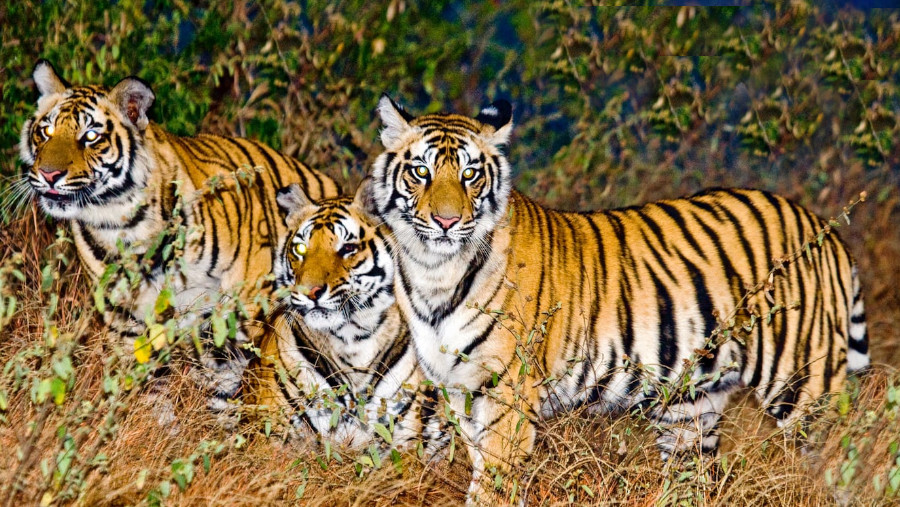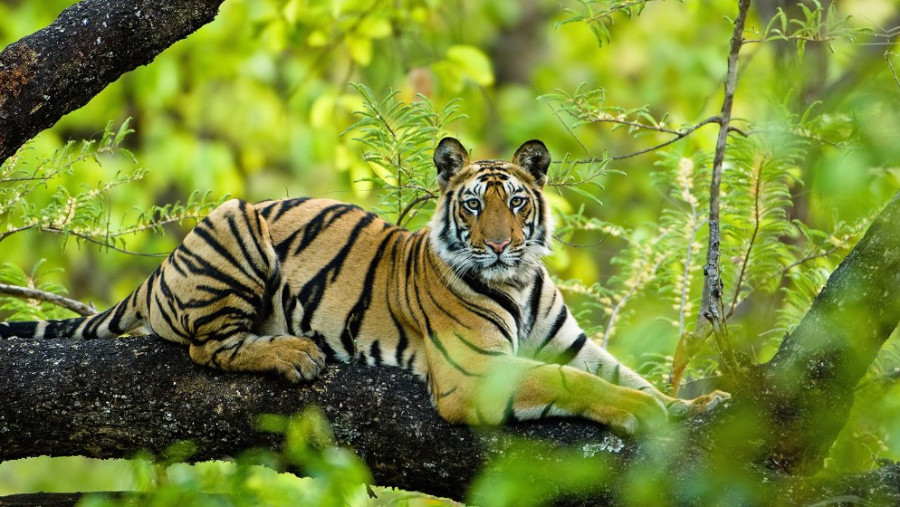Bandhavgarh National Park
Bandhavgarh National Park, the most popular national parks in India is located in the Vindhya Hills of the Umaria district in Madhya Pradesh. Declared as a national park in 1968 the Bandhavgarh National Park is spread across the area of 105 km². The name Bandhavgarh has been derived from the most prominent hillock of the area of Umaria. The area of Bandhavgarh is being flourished with a large biodiversity, the place which is also being famed to grip highest density of tiger population in India. Similarly, the park also beholds the largest breeding population of leopards and various species of deer. Over the years, the park has shown a great number of increases in the count of the tiger species and this is the reason why tiger tours is so famed to attract large amount of tourists at its vicinity.
The park has been divided into three major zones named as Tala, Magdi and Bamera out of which the Tala zone attracts major number of tourists by offering the tiger sighting opportunities. The park authorities are also focusing on the Magdi Zone by providing more opportunity to spot tigers. Elephant shows are also organized in Magdi zone of the Bandhavgarh national park to increase the chances of spotting the elusive king of the jungle.
Bandhavgarh National Park consists of mixed vegetations ranging from tall grasslands to thick Sal forest and so is the perfect habitat of variety of animals and birds. Due to varied topography, the Bandhavgarh national park provides ample opportunity to spot the majestic Indian tiger and some rarely seen animals like leopard and sloth bear. Due to high wildlife sighting it is becoming popular amongst tourists visiting India.
Area: 450 sq. km (Core area: 105 sq. km)
Altitude: 800 m above sea level
State: Madhya Pradesh
Location: Vindhyan Mountain ranges of central India
Temperature range: 42°C to 2°C
Annual Rainfall: 1200mm
Best time to visit: February-June (Closed 1 July-15 October)
Bandhavgarh National Park is dry deciduous forest and rich in varieties of flora and fauna. The moderate climate and favorable topography uniquely supports the growth of a rich and varied flora. The captivating landscapes are spread over 32 hills, cliffs, plateaus and meadows. Bandhavgarh Nationa Park mainly consists of Sal forest in the valleys and Bamboo stretches on the lower slopes of the region. Covered with fine trees of Sal and Bamboo, and vast grasslands.
About 300 species of flora can be found in Bandhavgarh. the perennial streams and rivulets flow at different crisscrossed zones of the park creating scenic vistas and budding importance to the jungle. The beautiful sceneries of this Indian Wildlife Park offer picturesque view to the tourists and nature lovers.
At Bandhavgarh National more than 22 species of mammals and 250 species of birds in the area with common langurs and rhesus macaque representing the primate group.
The Bandhavgarh national Park is best known as the white tiger country where large variety of tiger species can be found and were also being witnessed in the old state of Rewa since many years. The last one was captured by Maharaja Martand Singh in the year 1951 and today the white tiger called Mohun is on display in the palace of Maharaja of Rewa and Bandhavgarh reserve was maintained as the game preserve for him, where hunting was being proudly carried away as well as with their protection.
You can easily spot Bengal Tigers, Leopards, Sambar, Barking Deer, Nilgai, Wild Boar, Gaur, Chausingha and Chinkara, the Asiatic jackal, Bengal fox, sloth bear, ratel, grey mongoose, striped hyena, jungle cat, leopard and tiger. The artiodactyls frequently sighted are wild pig, spotted deer, samber, chausingha, nilgai and chinkara with mammals like dhole, the small Indian civet, palm squirrel and lesser bandicoot rat and little grebe, egret, lesser adjutant, sarus crane, black kite, crested serpent eagle, black vulture, Egyptian vulture, common peafowl, red jungle fowl, dove, parakeet, Indian roller can also be found in abundance. Reptilian fauna include cobra, krait, viper, ratsnake, python, turtle and a number of lizard varieties, including varanus.
Apart from that the park is home to variety of species of birds like Grey Hornbill, Common Teals, Red Jungle Fowl, and White Breasted Kingfisher etc.
Perenial Streams and marshes is natural habitation for more than 150 species of birds species in Bandhavgarh Reserve. The Vindhya ranges amd dense tropical forests, fields, scrub and wetland at Bandhavgarh attracts the birds and makes it their favorable habitat.
You will see amazing birds in vicinity of the Vindhya ranges are : Black Ibis, Brown Shrike, Long Tailed Shrike, Bay Backed Shrike, Common Iora, Lesser White Throat, Wooly Necked Stork, Crested Serpent Eagle, Pariah Kite, Changeable Eagle, White Eyed Buzzard, Yellow Crowned Woodpecker, Chestnut Shouldered , Shikra, Black Shouldered Kite, Rufous Treepie, Paddy Field Pipit, Richard's Pipit, Tawny Pipit, Indian Moorhen, Common Wood, Shrike, Honey, Buzzard, Common, Kestra, Petronia, Plum, Headed, Parakeet, Alexandrine Parakeet, Rose Ringed Parakeet, White Browed Fantail Flycatcher, Black Naped Monarch, Verditor Flycatcher, Little Green Bee Eater, , Red Vented Bulbul, Common Myna, Pied Starling, Barhminy Starling, Barred Button Quail, Black Rumped Flameback, Tree Pipit, Olive Backed Pipit, Black Headed Oriole, Golden Oriole, , Pied Kingfisher, Comb Duck, Ruddy Shellduck, Common Sand Piper, Wood Sand Piper, Green Sand Piper, Temminck's Stint, Eurasian Thicknee, Jungle Myna, Bank Myna, Magpie Robin, Indian Robin, Savanna Nightjar, Grey Headed Barbet, Crimson Breasted Barbet, Rufous Face Warbler, Little Cormorant, Black Redstart, Little Grebe, Jungle Bush Quail, Red Rumped Swallow, White Naped Woodpecker, White Breasted Waterhen, King Vulture, Bronze Wing Jacana, Lesser Whistling Teal, Asian Palm Swift, Wire Tail Swallow, Crested Tree Swift, Barn Swallow, Indian Bushlark, Ashy Crowned Sparrow , Lark, Rufous Tailed Lark, White Backed Vulture, Long Billed Vulture, Egyptian Vulture, Pond Heron, Ashy Prinia, Plain Prinia, Common Tailor Bird, Hoopoe, Red Wattled Lapwing, Yellow Wattled Lapwing, Gold Fronted Chloropsis, Tickell's Blue Flycatcher, Asian Paradise Flycatcher, Indian Roller, Oriental Turtle , Dove, Eurasian Collared Dove, Spotted Dove, Red Turtle Dove, Laughing Dove, Jungle Babbler, Large Gray Babbler, Gray Francolin, Peacock, Red Jungle Fowl, Blue Rock Pigeon, Pale Billed Flowerpecker, Thick Billed Flowerpecker, Coucal, Purple Sunbird, Common Hawk Cuckoo, Indian Hawk Cuckoo, Yellow Footed Green Pigeon, Bronze Dove, Black Drongo, Racket Tailed Drongo, White Bellied Drongo, , Stone Chat, Pied Buchchat, Little Egret, Cattle Egret, Great Egret, Cotton Pygmy Goose, Grey Lag Geese (Rare), Sarus Crane, Grey Hornbill, Hume's Warbler, Greenish Warbler, Common Chiff Chaff, Brown Fish Owl, Barn Owl, Short Eared Owl, Indian Scops Owl, , Spotted Owlet, Barred Jungle Owlet, Mottled Wood Owl (Calls), White Throated, Kingfisher, Common Kingfisher eatures. Your bird watching tour at Bandhavgarh is really an appreciating approach to the crown of Madhya Pradesh i.e. the Bandhavgarh National Park.
Best Time to Visit Bandhavgarh National Park is open for visitors from the 15th of October to till 30th of June. As per the climate of Central part of India, the peak season for Bandhavgarh National Park is during winters which is October to March. Most of the tourists visit the park between November and March, mainly because the summer's heat is unbearable. The period between November and February is excellent for visiting Bandhavgarh national park as the rain fall during monsoon rejuvenated all the nature & vegetation. During the time period from March to May most of the vegetation at Bandhavgarh National Park gets dried & Tiger Sighting is relatively easier than it is in winters.
Jungle Safari
Bandhavgarh National Park is heaven adventure lovers and wildlife photographers. Wildlife viewing in 4 WD Open gypsy is the best way to explore the flora & fauna of Bandhavgarh National Park’s untamed nature and unspoiled landscapes. Bandhavgarh National Park consists of mixed vegetations ranging from tall grasslands to thick Sal forest and so is the perfect habitat of variety of animals and birds. Jeep safaris keep one enthralled for the adventure and provide the flexibility to explore especially those places, which are difficult to travel via any other mode of transportation.
The best time to visit is during the dry season, from October to May. At Bandhavgarh Jeep Safaris can be done twice a day. The Morning Shift which starts early at the time of Sunrise up to 04 hrs & the afternoon one starts in between 02 PM to 03 PM up to sunset. Only 6 passengers are allowed in a jeep naturalist and driver. Limited Jeeps are permitted to enter inside the National Park in each shift. Therefore it is advisable to book safari rides in well advance to avoid any chance of unavailability.
By Road :Bandhavgarh National Park is well connected from the nearby town & cities like Jabalpur, Satna, Umaria, Khajuraho etc. Distance & approx driving time of Bandhavgarh National Park from some of the nearby cities are mentioned below:
Jabalpur : 200 Kms / 04 Hrs Drive
Katni : 100 Kms / 02 Hrs Drive
Kahjuraho : 250 Kms / 05 Hrs Drive
Nagpur : 490 Kms / 07 Hrs Drive
Umaria : 35 Kms / 01 Hrs Drive
Varanasi : 350 Kms / 07 Hrs Drive
Kanha National Park : 250 Kms / 05 Hrs Drive
By Train : The nearest railway stations for Bandhavgarh National Park are Umaria & Katni. Umaria is 35 Kms (45 Minutes drive) & Katni is 100 Kms (02 Hrs drive) from Bandhavgarh.
By Air :The nearest Airport for Bandhavgarh National Park is Jabalpur & Khajuraho. Jabalpur 200 Kms / 04 Hrs Drive & Khajuraho 250 Kms / 05 Hrs Drive from Bandhavgarh. One can get regular flights for Jabalpur & Khajuraho from all major airports of India.
Weather in Bandhavgarh
Climate is moderate temperature and heavy rail during Monsoon. The park stretches across the Vindhya Mountain Ranges in Central India. The climate of this wonderful reserve area can be broadly divided into three main seasons, i.e., chilly winters, sweltering summer and over pouring rainy season. The summer season continues from end March to the end of June when temperature can go up to 44o c during May-June. By mid June, rainy season starts with light drizzle. The average rainfall of Bandhavgarh National Park is 1133mm. Sometimes between the months of November and February rainfall takes place due to the effect of southern cyclones.
Woollen Layer Clothing is advisable during Winters mid NOV till mid FEBWinter season starts approaching from mid November and lasts till the end of February. During this period the visitors has to wear heavy layers of winter clothes as the mercury might go down to 2 degree . The open marshy hollows get covered with frost and the greenery looks impressive.
Bandhavgarh Safari Packages
Bandhavgarh Tiger Safari Packages
3 Day Badhavgarh Tiger Safari
Duration: 3 Days & 2 Nights
Price Onwards: Indian: Rs.13500/ Foreign: USD350
Bandhavgarh National Park famous for highest known density of tiger population in India and its wildlife includes gaur (Indian bison), sloth bear, leopard, porcupine, wild boar, sambhar and spotted deer, among others and of course, the Tiger. The Bandhavgarh national park is a jungle consisting mainly of sal trees.and vast stretches of grasslands and bamboo forests.....
Read More →4 Day Bandhavgarh Tiger Safari
Duration: 4 Days & 3 Nights
Price Onwards: Indian: Rs.21500/ Foreign: USD420
Bandhavgarh is known across the world for its dense big cat population. But there's much more to see besides the tigers and leopards. Chital (spotted deer), Sambar deer, dhole, nilgai, wild boar, chinkara, sloth bear, rhesus macaque, black faced langur, jungle cat, hyena, porcupine, jackal, fox and wild dog also inhabit these forests......
Read More →
